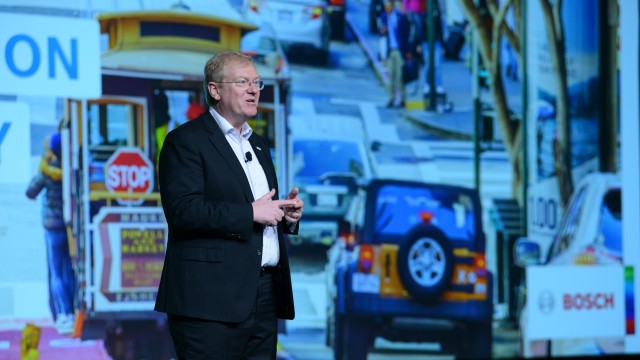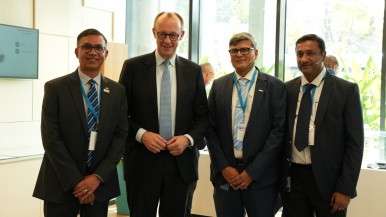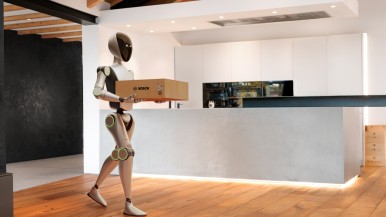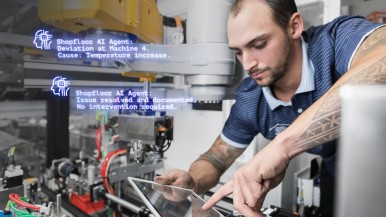Introduction
[Stefan Hartung]
Good morning, everyone. A very warm welcome to all of you, and thank you for joining our press conference. This is the first time I have the honor of representing Bosch at CES. I’m thrilled to finally have this opportunity because I’m probably one of the biggest techies on the Bosch board of management and have been following this event for several years. When we entered the smart home business, I made a point of personally trying out as much of our technology as I could in my own house. Some of my neighbors thought I had gone off the deep end when they saw me installing cameras everywhere and sensors in the doors and windows.
[Mike Mansuetti]
For all of us, the quality of the environment we live in is very important. And this is particularly true for those who live in cities. That’s why we want to show you today how we’re using our technical strengths to make a mark on cities around the globe. Let me start with a question – what do you imagine when you hear the term “connected” or “smart” cities?
[Stefan Hartung]
For my part, I think of cities in which we as citizens are more engaged and empowered, thanks to technologies that take care of things for us and save us time, and allow us to move, breathe, and actually LIVE better.
- Cities that utilize connectivity to help optimize traffic and reduce congestion.
- Cities in which we can minimize our ecological footprint because energy needs are met primarily by renewable sources.
- Cities that are full of smart homes that we can operate from anywhere, and buildings that arrange their own maintenance and repair before we even need to care.
- Cities that employ technology to reduce pollution and fight crime.
In short, cities that are intelligent and sustainable, and offer us a safe, energy-efficient, and all-around great place to live.
Sounds almost too good to be true, right? You might even say utopian. But it’s not. In fact, technologies to create this kind of urban environment exist, and many are already in use – perhaps even in your neighborhood. Step by step, cities and communities around the world are boosting their IQ. And we know this because we at Bosch are helping them do it. As one of the companies with the broadest and most comprehensive portfolios of smart-city solutions, as well as decades of cross-domain expertise, there’s no one better equipped for this job.
[Mike Mansuetti]
Market potential of smart cities
Globally, the smart city market is booming. Sales are expected to grow by 19 percent each year, reaching as much as 800 billion dollars worldwide by 2020. By 2025, at least 80 urban areas worldwide will be smart. Some places are already synonymous with smart-city initiatives: Barcelona, Seoul, London… or Columbus, Ohio, which as you may know, was the winner of the U.S. Department of Transportation Smart City Challenge.
Around the globe, cities of all sizes are investing in and reaping the benefits of these technologies. In fact, the city of Las Vegas recently announced a 500 million dollar investment in smart city infrastructure over the next seven years.
[Stefan Hartung]
About the smart city market: one reason it’s taking off now is because we have the right technology. The arrival of the IoT a few years ago, with its innovations in sensors, artificial intelligence, big data, and predictive analytics, means that many smart city initiatives are for the first time not only possible, but also economically viable. Perhaps more importantly, though, cities are realizing that technological solutions could hold the key to solving many of today’s pressing urban problems – as well as tomorrow’s.
The fact is that our world is becoming increasingly urbanized: by 2025, 34 cities worldwide will have a population of more than 10 million people. By 2050 at the latest, two-thirds of the world’s population will be living in these megacities, putting a tremendous amount of pressure on local infrastructure and the environment – and ultimately on our quality of life, whether the air we breathe, the time we waste in traffic, the energy we consume, or our safety. Smart city technologies offer a way of confronting these challenges, and of mitigating their impact. Above all, they help make cities – and towns, and neighborhoods – better places to live. We’re pursuing exactly this aim in 14 smart-city beacon projects around the world, for example in Tianjin, China, Berlin, Germany, and San Francisco, California.
Sensors, software, and services
Smart cities begin and end with connectivity. Our solutions not only encompass connected mobility, energy, building, and industrial technology, they enable connectivity at the most fundamental level. Nearly 50 years ago, we introduced semiconductor technology for automotive applications. Today we’re the leading global producer of micromechanical sensors, shipping more than four million a day.
[Mike Mansuetti]
You could say that our sensors are the eyes and ears of the connected city. In this case, its brain is our software. Of Bosch’s nearly 400,000 associates worldwide, more than 20,000 are software engineers, nearly 20 percent of whom are working exclusively on the IoT. We supply an open software platform called the Bosch IoT Suite, which offers all the functions necessary to connect devices, users, and companies. And we’re increasingly bringing artificial intelligence into play here as well – at the start of last year we even opened a dedicated AI research center, which employs some 100 experts at three locations, one of them in Silicon Valley.
Since 2016, we’ve been operating our own IoT cloud in Germany. Over the past 18 months, we have implemented some 100 IoT projects and connected one-point-five million vehicles with our IoT software. Later this spring, we plan to launch the Bosch cloud on this side of the Atlantic. In fact, we intend to make all the electronic products in our portfolio web-enabled by 2020, and offer them with a corresponding service package.
Sensors, software, services – these three S’s are not only the building blocks of smart cities, at Bosch they are our core competencies.
[Stefan Hartung]
And they’re also the basis of our smart city solutions, which I’d like to tell you about now in more detail. What’s important to understand here is that there is no switch that gets flipped to make a city smart. Instead, intelligence comes in stages, as cities start implementing technology to overcome the four major challenges they face, one step at a time.
Challenge 1: air quality
The first challenge, and one of the biggest currently faced by cities around the globe, is air quality. The importance of this cannot be overstated – it’s fundamental to our mental and physical well-being, wherever in the world we live. We at Bosch believe that there is no single magic bullet that will solve this problem. Instead, what will have a lasting impact on air quality is an array of measures working in parallel. Where mobility is concerned, these include state-of-the-art combustion engines, hybrid solutions, and pure electromobility, as well as connectivity that goes beyond individual vehicles.
Another key piece of the puzzle is climate monitoring systems. These gather data about air quality in a particular region which can be used to develop targeted measures for reducing pollution. Here at CES, we’re presenting our innovative new microclimate monitoring system which is flexible, affordable, and easy to deploy.
[Mike Mansuetti]
And it has a name you can easily remember – Climo. To give you some context, most microclimate monitoring stations are usually roughly the size of shipping containers – not to mention expensive. We’ve packaged ours into this little box, 1/100th of the conventional size, and 1/10th of the cost. In addition to pollution, it also measures humidity and pollen levels in real time – a great advantage for local residents. For cities, the data provided can be utilized in a variety of ways, such as for traffic flow management and as the basis for future policy and planning decisions. The Consumer Technology Association was so impressed with Climo that they gave it one of the coveted CES Innovation Awards in the smart city category – one of three awards we received this year. We recently provided the city of Las Vegas with several Climo systems. During CES, Bosch will be monitoring the local air quality in real time.
[Stefan Hartung]
Challenge 2: mobility
Let’s move on to the second challenge, and another major focus of smart city initiatives – mobility. It’s no wonder: growing populations mean more traffic. In fact, urban traffic is predicted to triple by 2050. To help cities and their inhabitants cope with this, Bosch is developing a wide variety of solutions for the transportation of people and goods. Our vision is to create an urban environment that is free of emissions, stress, and accidents. This is tied to three technological developments: automation, electrification, and connectivity.
Today, half of our 14 smart city projects include urban mobility solutions such as connected parking, automated driving, fleet management, multimodal transport, and electromobility. Let’s start with parking, one of the most common frustrations of city life.
[Mike Mansuetti]
In the U.S., we currently spend over 40 hours a year stuck in traffic, wasting more than 160 billion dollars in time and fuel. The search for parking accounts for more than a third of this wasted time. You have personal experience with this, right? I know I certainly do. Our solutions for connected and automated parking save fuel and time while reducing stress.
In one of these solutions, community-based parking, we at Bosch are taking over the search for a parking spot. It works by cars automatically reporting vacant spaces to the cloud as they drive past. After a successful pilot phase, we’re currently planning to launch community-based parking in 20 U.S. cities this year. In places such as L.A., Miami, and Boston, we’ll make real-time information about on-street parking available to car manufacturers. Drivers will be able to see on their navigation systems where there’s a free space and drive directly to it – which will save them time, fuel, and stress, while reducing congestion and pollution in downtown areas.
[Stefan Hartung]
Our latest innovation is called automated valet parking. We recently won a Frost & Sullivan's 2017 Technology Innovation Award for this solution. It works like this: cars drive themselves into parking garages and find their own spaces at the touch of a button – while you, the driver, can attend to more important things. In cooperation with Daimler, we recently demonstrated this futuristic solution live at the Mercedes-Benz museum in Stuttgart.
Speaking about automated mobility, Bosch has over 3,000 engineers worldwide working to make this a reality. In one of our projects, we’re again collaborating with Daimler to bring self-driving robocabs to city streets by the start of the next decade. This will open up new horizons in particular for people with limited mobility – such as the elderly, or those with disabilities. We’re also taking steps to realize another requirement for self-driving cars, namely high definition maps.
To this end, we recently acquired a stake in the map provider HERE Technologies, and together with them, we’re working on a manufacturer-independent solution for cars to share traffic information collected by their sensors, which can be used to update maps in real time. We’ll also be working together on applications for this technology beyond the automotive domain – for example in connected industry, where high-definition indoor maps could be used to automate and streamline flows of goods all the way to the production line.
[Mike Mansuetti]
But to return to mobility: smart cities will also rely heavily on multimodal transportation – in other words, getting from A to B on four wheels, two wheels, or by rail. One way Bosch is facilitating this is with innovative shared mobility services. A great example is our Coup e-scooter sharing service, which we’ve so far successfully launched in Berlin and Paris. We know there is an increasing population of people who want to remain mobile without owning a car, and this kind of service offers them that opportunity.
According to Gartner, 250 million cars around the world will be connected by 2020. Along with this development, automotive services are also gaining in importance. Come to our booth to see what we call our connected vehicle platform – it brings together the numerous vehicle services we now offer. From wrong-way driver alert and preventive diagnostics to stolen vehicle tracking and smart-home control from behind the wheel, we’re not only making driving easier, safer, and more convenient than it’s ever been before, we’re turning the car into a new, fully-connected living environment.
Our new Telematics eCall Plug is enabling another kind of service that combines safety with savings. The device itself is a plug which fits into a standard 12 volt outlet in any passenger vehicle. In addition to offering our lifesaving eCall emergency accident notification, the plug now also has a sensor that monitors driving behavior. An insurance company could use this information to offer you lower rates when you’re a careful driver.
[Stefan Hartung]
Challenge 3: energy
Energy use presents the third major challenge for cities. Cities already account for some 75 percent of power consumption around the world, with 40 percent going to buildings alone. Smart city technology can not only help reduce consumption, but also make the use of renewables a more viable prospect. This means that ultimately it can help people save money and reduce their ecological footprint – good for cities, and good for their inhabitants.
At Bosch, our energy solutions include virtual power plants, which store power or feed it into the grid as needed, and stationary energy storage systems – essentially massive batteries that can store enough energy to power dozens of homes.
[Mike Mansuetti]
We’re also at the forefront of microgrid technology. Without getting too technical, microgrids are relatively small, independently controlled energy-management systems. Think of them as miniature versions of municipal grids, generating and distributing electricity on a much smaller scale. Their ability to run on a variety of fuel sources, including renewables, means they have excellent ecological credentials. Another major advantage is increased self-sufficiency – microgrids can provide power for local residents and critical facilities if an outage affects the larger grid. In 2015, we outfitted a facility at Fort Bragg in North Carolina with a solar-based microgrid solution that supplies cost-effective, eco-friendly electricity.
[Stefan Hartung]
Challenge 4: safety and security
That brings me to the final challenge, safety and security. Anyone who lives in a city knows that these are already major concerns, and growing populations will only make the situation more acute.
At Bosch, we also have a full portfolio of solutions designed to keep individuals and communities safe. For example, our connected surveillance cameras can be used to fight crime, and they can also identify where help is needed in the event of a catastrophe.
Another security solution we’re debuting here is our new flood monitoring system. This provides early warning about potential flooding by digitally monitoring water levels in real time. Up to now, such measurements have been made using mechanical means, which means several hours can pass before a warning is issued. Our system uses a combination of ultrasonic sensor probes and cameras to monitor changes to water level, speed, and throughput, and immediately sends out notifications when critical thresholds have been surpassed. A local municipality could install our system on bridges and allow residents to access data and receive alarms, for instance, or a business owner could set up a private system to protect their premises. We currently have a test system in place on the Neckar river near the Bosch headquarters in Stuttgart.
Smart homes and buildings will unlock potential of smart cities
Looking beyond these major challenges, we believe that in order to unlock the full potential of smart cities, the homes and buildings inside them will need to be intelligent as well. Smart home technologies offer countless benefits: they can take care of time-consuming chores for us, enable us to save energy and money, and make our living spaces more secure.
At Bosch, we have been on the forefront of smart-home technology for years. In addition to our ever-growing range of connected appliances, lighting, and indoor climate systems, which by the way, can now be controlled with Amazon’s Alexa, we’re constantly expanding the scope of the smart home’s capabilities. For instance, we have a new robotic vacuum cleaner equipped with AI that can memorize your floor plan, and save you up to 40 hours of work each year.
We also received a CES Innovation Award this year for a new acceleration sensor that is small and powerful, yet extremely energy-efficient. Among other things, the sensor can recognize whether windows are open or closed, and automatically adapt heating and cooling systems accordingly. Isn’t that smart? This saves money and power.
[Mike Mansuetti]
On a public scale, we’re helping to make all types of buildings smart – among them hospitals. For example, sensor-based video technology, lighting, and motion detectors can be used in hospitals to boost safety and security. Connected solutions also provide greater convenience and efficiency for both patients and administrators. Our U.S. subsidiary Climatec is a longstanding partner of the nonprofit provider Banner Health. We currently supply building automation, security, and fire detection equipment for 15 Banner facilities. In the years ahead, we expect continued growth with our global building technology business, and plan to increase our revenue in this sector by more than 20 percent.
Beacon projects: SF Shipyard and San Leandro
Before we wrap up, I’d like to tell you about a couple of the smart-city projects we’re involved in. Two of them are, in fact, right next door in California.
The first is a partnership with the city of San Leandro, in the Bay Area. There, we’ve outfitted 5,000 streetlights with smart LED lighting that will switch on only when needed. The city estimates that this alone will save them more than 8 million dollars over the next 15 years. We’ve also equipped the streetlights with sensors that measure air quality and intelligent cameras that monitor traffic and automatically redirect cars in case of congestion. So besides enhancing quality of life, smart city technology can also save you – and cities – money.
The other partnership is in San Francisco. This waterfront site is comprised of two neighborhoods – the former Hunters Point Navy Shipyard and Candlestick Park, where the 49ers used to play. Together, The SF Shipyard and Candlestick are entitled for up to 12,000 homes, five million sf of commercial space and one million sf of retail, all of which are being developed by FivePoint. At The SF Shipyard, we’re providing residents with a state-of-the-art surveillance system. We do this with our intelligent cameras and on-site monitoring systems. Both of these are connected to our smart community app. This app contributes to creating a sense of community and enhances the quality of the neighborhood by helping residents find local business information, check real-time transportation schedules and share information with other community members. A number of other cost-effective and eco-friendly solutions, including a DC microgrid powered by solar energy, are currently being explored.
[Stefan Hartung]
Conclusion: focusing on the bigger picture
As you can see, we have no shortage of cutting-edge solutions for smart cities. With all this talk about technology, though, we shouldn’t lose sight of the bigger picture. We at Bosch are committed to helping make cities smart not just because it makes good business sense, but because it actually improves people’s lives. Smart cities facilitate civic engagement. They allow the use of finite resources to be reduced and renewables to be increased. They enable the elderly and people with disabilities to enjoy more independence. They help protect people’s health and make streets safer. And they take the stress out of many everyday activities. This is what we mean when we say our technology is “Invented for life.”
Ladies and gentlemen, in closing let me repeat that the smart city of the future is no utopian vision: it’s already here, and communities around the globe are reaping the benefits. At the same time, though, the challenges faced by cities are formidable. Overcoming them will require pulling out all the stops, both technologically and politically. This is exactly where Bosch has the advantage: not only do we have a truly comprehensive portfolio and cross-domain expertise, we have experience working with municipalities to supply exactly the solutions they need. Solutions that will make life tangibly better for you, me, and everyone living in our neighborhoods.
But don’t just take our word for it. Come and visit our booth in Central Hall this week, and experience for yourself Bosch’s connected and life-enhancing solutions for the smart cities of tomorrow – and today.
Thank you.





